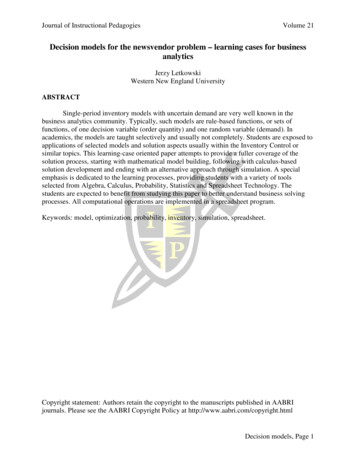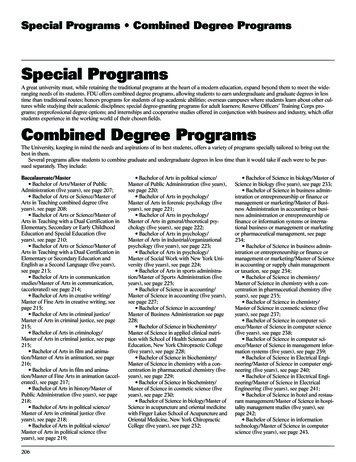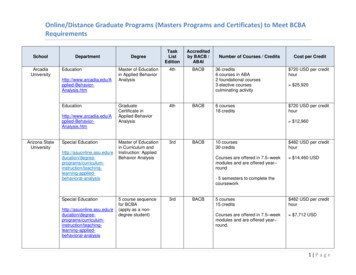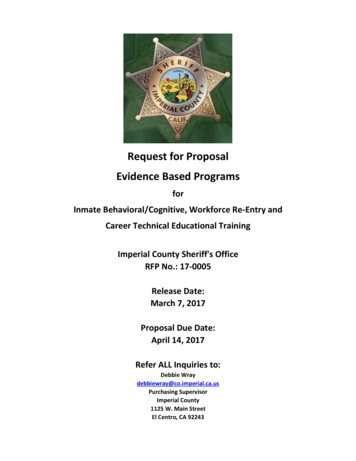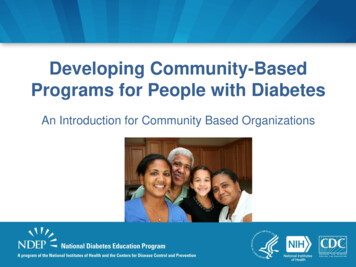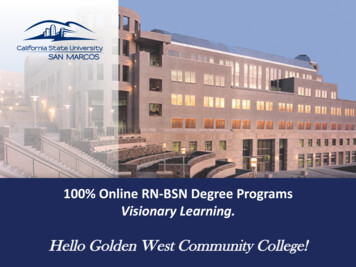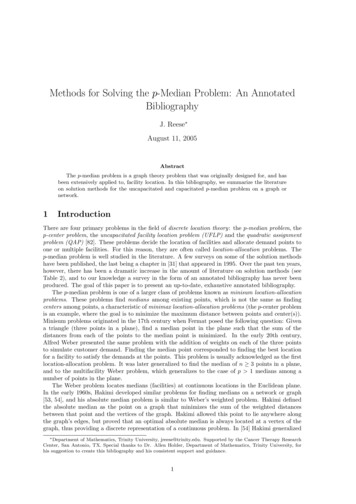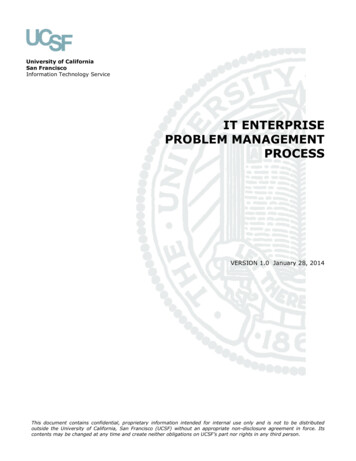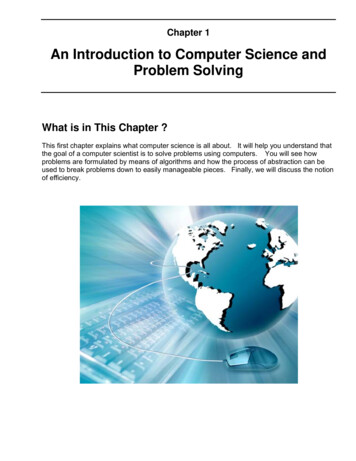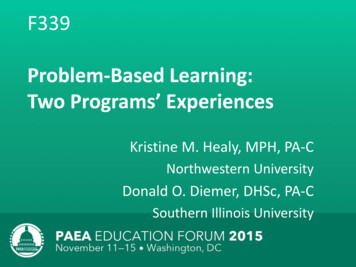
Transcription
F339Problem-Based Learning:Two Programs’ ExperiencesKristine M. Healy, MPH, PA-CNorthwestern UniversityDonald O. Diemer, DHSc, PA-CSouthern Illinois University
Goal and Learning Objectives This session proposes to inform attendees about how twoprograms feature PBL as core methodology. At the conclusion of this session, participants will be ableto:– define problem-based learning (PBL), identify key componentsof PBL, and distinguish PBL from case-based learning;– describe PBL connections to ARC-PA Accreditation Standardsand the Competencies for the Physician Assistant Profession;– describe educational methodologies and resources utilized bytwo programs that incorporate PBL throughout their pre-clinicalyear curricula;– compare and contrast two approaches to PBL;– list advantages and disadvantages of PBL as core curricula.
What is PBL? Problem-based learning (PBL) is described as discovery learning which helps students, in smallgroups with a faculty tutor/guide, “develop scientific thinking about patient problems and toacquire basic science and clinical information in a mannerthat ensures retention and transfer to the real-life task ofthe clinician.” (1) Problem based learning or PBL develops effective clinical reasoning and self-directed learningskills within a context of solving clinical problems. (2)(1) Barrows, HS, Tamblyn, RB. Problem-Based Learning: An Approach to Medical Education, New York, NY: Springer; 1980:xii.(2) Van Rhee, JA, Wardley, S, Hutchinson, CA, Applegate, EB, Vangsnes, EH, Meyer, JM, Grinwis, BA, Fenn, WH. Problem-based Learning inPhysician Assistant Education: Establishing a Basis for a Comparative Study, Journal of PA Education. 2003;14(4):242-248).
PBL HistoryPBL embraced by medical educationin 1969 Howard Barrows McMaster University in Ontario Since then, adopted by medicalschools, undergraduate studies,and K-12 In PA education still relatively lowpercentage Disadvantages Absence of research oneffectiveness Differences between PA andMedical SchoolHoward S. Barrows, MD (left) withLaurie Dunn-Ryznyk, MPAS, PA-C atSIUCamp, G. Problem-Based Learning: A Paradigm Shift or a Passing Fad? Medical Education Online, 1.doi:http://dx.doi.org/10.3402/meo.v1i.4282.
What is Case-based Education?Dr. Barrows outlined several methods to deliver patient problems within curricula1.Lecture-Based CasesA lecture is presented by an instructor and then case vignettes are presented to illustrate the relevance of thelecture.2.Case-Based LecturesStudents are presented with case vignettes and given the opportunity to review them before a scheduled lecture.The lecture addresses principles brought forth by the cases.3.Case MethodStudents are provided with a complete case and expected to research and study the inherent issues of the case.The case will then be discussed in a subsequent class as part of a student interactive session, with an instructorpresent to facilitate discussion. Students study a case that has been completed, but do not manage the case.4.Modified Case-Based MethodStudents meet in small groups, called tutorial groups. A patient problem is presented to the group and studentsdecide on questions to ask and some actions to take. The format of the case is a brief module, and thereforeinquiry and actions are restricted. Students do not come back to the case with additional actions.5.Problem-Based LearningA patient problem is presented to the students in a format that allows for free inquiry. Students receive data fromthe case through this inquiry and through various steps within the clinical reasoning process. The students areusually involved in a small, tutorial group with a faculty facilitator (the tutor) guiding the discussion. However, asnew information is learned, students do not revisit the problem, they do not apply the new knowledge to theproblem.6.Closed Loop or Reiterative Problem-Based LearningStudents are presented with a patient problem in a format that allows for free inquiry (the same type of format asin the previous method). However, students are expected to explore learning issues through self-directedlearning and then to return to the patient problem, continuing with the clinical reasoning process. A subsequentself-directed learning session may be required, and the case completed after new information is applied.Barrows HS. A taxonomy of problem-based learning methods. Med Educ. 1986;20:481- 486. [As reported by Scott, QO. et al(see presentation references)]
PBL in PA Education 2005 (137 ARC-PA Accredited Programs) Most PA programs incorporated some PBL in their curricula Seven programs of the 77 respondents used PBL in 50% or moreof their coursework* 2015 (196 ARC-PA Accredited Programs) Presenters conducted two Google searches on May 11, 2015 Search 1 Terms– “problem based learning (PBL) in physician assistant (PA) education” Search 2 Terms– “problem based learning (PBL) in physician assistant (PA) programs” First four pages of each search analyzed PA program websites identified by searches further analyzed using the term “problem based” 2015 Bottom line Eight programs appear to incorporate PBL as a coremethodology Another four programs include some PBL within at least onecourse of first year curricula*Scott, QO, Lloyd, L, Kelly, C. Problem-Based Learning in Physician Assistant Training Programs, Journal of PA Education.2005;16(2):84-88).
How PBL Meets ARC-PA StandardsThe curriculum must include B1 Curriculum Standards established and evolving biomedical and clinical sciencesand the application of this knowledge to patient care. sufficient breadth and depth to prepare the student for theclinical practice of medicine. sequencing that enables students to develop thecompetencies necessary for current and evolving clinicalpractice. ANNOTATION: The concept of sequencing refers to thecoordination and integration of content both horizontallyand vertically across the curriculum. It does not mandate thatcontent be delivered in separate courses with traditionaldiscipline names. Appropriate sequencing involves consideringoverall program design and integration of content. Contentand course sequencing are expected to build upon previouslyachieved student learning. instruction to prepare students to provide medical care topatients from diverse populations. ANNOTATION: Quality health care education involves anongoing consideration of the constantly changing health caresystem and the impact of racial, ethnic and socioeconomichealth disparities on health care delivery. Instruction relatedto medical care and diversity prepares students to evaluatetheir own values and avoid stereotyping. It assists them inbecoming aware of differing health beliefs, values andexpectations of patients and other health care professionalsthat can affect communication, decision-making, complianceand health outcomes. instruction related to the development of problem solvingand medical decision-making skills. instruction to prepare students to work collaboratively ininterprofessional patient centered teams.B2 Clin. Prep. Instruction Standards applied medical sciences (anatomy, physiology, genetics,molecular principles, pathophysiology,pharmacology/pharmacotherapuetics) and their applicationin clinical practice. clinical medicine covering all organ systems. interpersonal and communication skills that result in theeffective exchange of information and collaboration withpatients, their families and other health professionals. patient evaluation, diagnosis and management. ANNOTATION: Instruction in patient assessment andmanagement includes caring for patients of all ages frominitial presentation through ongoing follow-up. It includesinstruction in interviewing and eliciting a medical history;performing complete and focused physical examinations;generating differential diagnoses; and ordering andinterpreting diagnostic studies. Patient managementinstruction addresses acute and longitudinal management.Instruction related to treatment plans is patient centered andinclusive, addressing medical issues, patient education andreferral. provision of clinical medical care across the life span. prepare students to search, interpret and evaluate themedical literature, including its application to individualizedpatient care. health care delivery systems and health policy. concepts of public health as they relate to the role of thepracticing PA.Accreditation Standards for Physician Assistant Education. Fourth edition. First Published March, 2010. Effective September1, 2010. Clarifications 7/2010, 10/2011, 9/2012, 12/2012, 9/2013, 9/2014.
Competencies for the PA ProfessionMedical Knowledge(Originally adopted 2005; revised 2012) synthesis of pathophysiology, patient presentation, differential diagnosis, patient management, surgical principles, healthpromotion, and disease prevention .Interpersonal and Communications Skills encompass the verbal, nonverbal, written, and electronic exchange of information demonstrate interpersonal and communication skills that result in effective information exchange with patients, patients’families, physicians, professional associates, and other individuals within the health care systemPatient Care patient- and setting-specific assessment, evaluation, and management demonstrate care that is effective, safe, high quality, and equitable PAs are expected to: make decisions about diagnostic and therapeutic interventions based on patient information and preferences, currentscientific evidence, and informed clinical judgment develop and implement patient management plans counsel and educate patients and their families provide health care services and education aimed at disease prevention and health maintenance use information technology to support patient care decisions and patient educationProfessionalism PAs must acknowledge their professional and personal limitations PAs must demonstrate a high level of responsibility, ethical practice, sensitivity to a diverse patient population, andadherence to legal and regulatory requirementsPractice-based Learning and Improvement processes through which physician assistants engage in critical analysis of their own practice experience, the medicalliterature, and other information resources for the purposes of self- and practice-improvement. PAs must be able to assess, evaluate, and improve their patient care practicesSystems-based Practice societal, organizational, and economic environments in which health care is delivered. Physician assistants mustdemonstrate an awareness of and responsiveness to the larger system of health care to provide patient care that balancesquality and cost, while maintaining the primacy of the individual patient. PAs should work to improve the health careComplete document available atsystem of which their practices are a spx?id 2178 ?id 3104
PBL in Two ProgramsSouthern Illinois and Northwestern1)2)3)4)5)6)Overarching curricula modelsPBL within these curriculaEducational technologies/methodologies usedAdvantages and disadvantagesStudent and graduate outcomesLessons learned and future plans
Our MissionsTo prepare healthcareprofessionals to provideprimary health care tounderserved populations inrural and health professionalshortage areas. We will enhancethis healthcare by preparinggraduates who are interdependentmedical providers, dedicated toboth community andprofession. The academic settingwill foster creative thinking andcommunication skills in our pursuitof excellence.To prepare PAs to providecompassionate,high-quality,patient-centered care asmembers ofinterdisciplinary teams. Thegraduates will beculturally competent,committed to continuous learningand professional development,and make significant contributionsto communities and theadvancement of the PAprofession.
Some ComparisonsLocationCurriculumDesignWheredoes PBL fitincurriculumPBL - startSIU SOM PA ProgramCarbondale (year 1)Hub system southern IL (year2)PBL Hybrid ModelOrgan System approachQ 8 weeks -- organ systemchangedEntire curriculumYear 1: one case per weekYear 2: three cases per rotation(5-6 weeks)OrientationWeek 1NU FSM PA ProgramChicago (year 1)Chicago Metro (year 2)PBL Hybrid ModelOrgan System approachQ 4 weeks -- organ systemchangedClinical Medicine I, II, III(each trimester 16 weeks inlength)Overview during orientationFirst PBL group meeting day 1of week 1
SIU Year One Courses PA ProfessionDiversity I, II, III, IV, VPharmacology I, II, III, IV, VClinically Integrated Anatomic Sciences I, II, III, IV, VPatient Evaluation I, II, III, IV, VPatient Education I, II, III, IV, VResearch Methods & EBM I, II, III, IV, VProcedural Skills I, II, III, IV, VClinical Mentoring I, II, III, IV, VOrgan Systems (8 Weeks Each)Unit 1Unit 2Unit 3Unit 4Unit yCardiovascularPulmonology
NU Pre-clinical Year Courses Basic sciences I, II, IIIPatient assessment I, II, IIIBehavioral and Preventive Medicine I, II, IIIClinical laboratory medicine I, II, IIIClinical medicine I, II, IIIPharmacotherapeutics I, II, IIIPreparing Future PAsBioethicsMastering Medical InformationMedical Spanish (basic and/or advanced)Pre-clinical year prep courseOrgan Systems (4 Weeks Each)Semester 1Semester 2Semester atology/Infectious DiseaseGI/NutritionMusculoskeletalEmergency Med/Clinical Skills
Hardware forPBLSoftware andOther Needsfor PBL CasesSpace needsHours for PBLFacultyStudent groupsSIU SOM PA ProgramNU FSM PA ProgramProgram computers and large TVmonitors in each PBL room; students withlaptops, notebooks; Internet accessYr 1: Each unit utilizes a mixtu
acquire basic science and clinical information in a manner that ensures retention and transfer to the real-life task of the clinician.” (1) Problem based learning or PBL develops effective clinical reasoning and self-directed learning skills within a context of solving clinical problems. (2) (1) Barrows, HS, Tamblyn, RB. Problem-Based Learning: An Approach to Medical Education, New .
